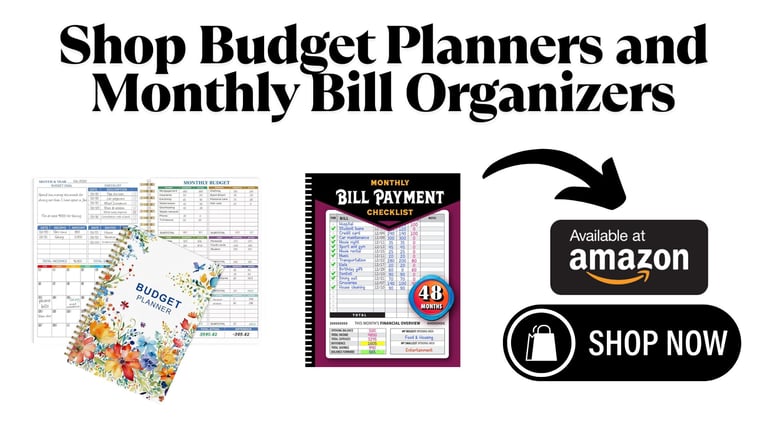How to Save Money: Practical Steps for Women Building Financial Security [Updated 2025]
Find out how to save money with smart, everyday changes. Women can use clear steps to protect what they earn and create lasting financial security.
LIFESTYLE INSPIRATION
5/29/202515 min read
As an Amazon affiliate, we earn commissions at no extra cost to you if you click our links and make a purchase.


Saving money feels easier said than done, especially when you’ve got to stretch every dollar to cover what your heart—and your family—needs.
With challenges like the gender pay gap, time away from work to care for others, and unexpected life turns, it’s not just about numbers. It becomes personal.
If you’re struggling to find balance, you aren’t alone, and there’s no shame in starting where you are. Learning how to save money can be a powerful act of self-care and strength.
Every positive change, no matter how small, begins with a single choice.
Here, we’ll talk about simple, steps you can use to build your financial confidence and create a safety net—one that works for you and your dreams.
You might be surprised how a few smart decisions can lead to a brighter, more stable future.
Let’s walk this road together.
Assessing Your Financial Situation
Before you can save money, you need a clear picture of what’s coming in and going out.
For many women, especially when every dollar matters, this step can help turn chaos into calm.
Living in the gray area of “hoping it works out” is stressful.
When you look closely at the numbers, it’s like turning on a light in a dark room—you start to see where you can breathe.
Let’s start by naming your income, exploring your spending habits, and coming to terms with any debts.


Analyzing Income Streams
First, count every source of money you receive.
Your main paycheck might be the biggest, but don’t skip side gigs, child support, alimony, or even the odd $20 from selling clothes online.
Knowing your full income makes it easier to plan. It also shows where you have gaps and where you might have more control than you thought.
For women working part-time, juggling caregiver roles, or working freelance, income can differ from month to month.
Gather bank statements or check stubs for the last few months and write down:
Regular paychecks (after taxes and deductions)
Gig jobs or freelance work
Child support or alimony
Government aid or benefits
Extra cash from sales, teaching, or creative work
List each one on paper or in a simple spreadsheet. If your income changes, find the average over three to six months.
This step is less about judgment and more about being honest. It’s the first step toward how to save money that actually fits your real life.
Tracking Spending Habits
Next, bring your attention to where your money goes. In busy seasons, it’s easy for small expenses to slip by unnoticed.
Opening up your spending is like opening the pantry door—you see what’s really there, not what you think is there.
Start simple:
Gather your bank and credit card statements for one to three months.
Write down every expense. Use categories like groceries, housing, childcare, health, debt, and treats.
Highlight monthly bills versus one-time purchases or small “just because” spends.
Often, people find surprises—subscriptions they forgot, small splurges that add up, or fees they never questioned.
If you prefer apps, there are free options that can help track every cent.
Here are a few ways to make it easier:
Use a notebook or an app on your phone.
Set aside a few minutes each week to update your list.
Celebrate small wins, like cutting back on takeout.
Being aware of your spending is tender work, not a punishment. It puts you in the driver’s seat instead of feeling lost when payday comes around.
Understanding and Managing Debt
Debt can feel heavy and hard to talk about, especially if you feel it’s grown quietly over time.
The truth is, many women carry debt because they’ve supported loved ones, covered household needs, or navigated rough patches alone.
To face debt head-on:
List every loan, credit card, medical bill, or informal debt.
Write down the balance, interest rate, and minimum payment for each.
Note due dates and which debts are most urgent.
Understanding your debt doesn’t mean drowning in numbers. It’s about clarity. If you see high-interest debt, you can build a plan to pay off what costs you the most first.
If you’re behind, reach out to lenders. Many have hardship options available. Remember, there’s no shame in having debt—there’s strength in finding a path through it.
Looking your debt in the eye takes courage, but it’s one of the most loving things you can do for your future self.
Each step you take to understand your financial picture gets you closer to real and lasting change.
Creating a Practical Budget That Works
Finding a budget that actually fits your life is one of the best ways to start saving money—even if your income feels unpredictable or thin.
A budget isn’t about counting every penny until you feel squeezed; it’s a tool to help you breathe easier and see where your money can make a real difference.
For many women, especially those supporting others or working through tough patches, a simple and practical plan can turn wishful thoughts of saving into something real and lasting.


Choosing a Budgeting Method (Zero-Based, 50/30/20 Rule, Envelopes)
Every woman’s life is different, so the right budget method is the one that feels natural for you.
You don’t need fancy spreadsheets or apps to start—just a little time, a bit of honesty, and the willingness to try.
Here are three tried-and-true approaches:
Zero-Based Budget Every dollar you earn is given a specific job, from bills to groceries to a small treat for yourself. When you’re done, every cent has a place, and your income minus expenses equals zero. Nothing slips through the cracks.
50/30/20 Rule This simple plan splits your take-home pay:
50% goes to needs—these are the must-pay bills.
30% is for wants—like an occasional dinner out or a new book.
20% goes toward savings and paying down debts. This rule gives you structure but enough room to adjust when things change.
Envelope System Perfect for anyone who likes things you can touch and see. Label envelopes with expense categories (like groceries or gas). Fill them with the cash you can spend in each group. When the envelope is empty, you wait until next time. It’s simple and sets clear limits.
Start with the method that sounds least stressful. You can always switch later if you need to, but picking one sets everything else in motion.
Essential vs. Non-Essential Expenses
It’s easy to spend on habit or out of comfort, but a big part of how to save money is learning to tell the difference between what you need and what you want. When you list your expenses, ask: Does this keep my home safe, put food on the table, or support my health?
Essential Expenses (Needs):
Rent or mortgage
Utilities and basic phone service
Groceries
Transportation (gas, bus fare)
Childcare
Insurance
Non-Essential Expenses (Wants):
Eating out
Streaming subscriptions
New clothes (outside of real need)
Salon visits
Extra home decor
If it helps, color-code or mark your expenses so you see where your money goes. Most of us find a few surprises.
Trimming just a few non-essentials can free up money you never knew you had. You don’t have to cut all the treats—pick the ones that matter most, and try to let go of the rest.

Top Saving Habits for Women
Watch Video...
Adjusting Your Budget for Changing Needs
Life changes, sometimes by the day. Kids grow, jobs come and go, and health surprises us.
The best budgets are not set in stone—they move with you, like a good friend in your corner.
Review your budget once a month, or any time your income or bills change.
If an emergency comes up, don’t panic. Pause, look at your spending, and shift things around to cover what’s most important.
Celebrate small wins. Did you put $20 more toward savings this month? That’s real progress.
When you get a raise, tax refund, or even just a cash birthday gift, consider putting a bit more toward savings or paying down debt.
Give yourself permission to adjust. A budget that works with you, not against you, is the real secret to saving money now and for your future.
Taking control in small steps is an act of courage and self-respect.
Smart Strategies to Cut Everyday Expenses
Living on a tight budget often feels like choosing between what’s necessary and what brings joy.
But finding places to save money doesn’t have to mean cutting out all comfort or letting go of connection.
With a few mindful adjustments, even in the middle of stress, you can carve out space in your wallet for what matters most to you and your family.
Here’s how to save money by tackling everyday expenses in simple, gentle steps that fit real life.


Saving on Food and Groceries
Groceries eat up a big part of any budget, and when times feel tough, every shopping trip counts. Small changes at the store can lead to bigger savings than you might expect.
Plan meals ahead: Write out a basic meal plan for the week before shopping. Start with what’s already in your pantry, then plug in just what you need to fill gaps.
Stick to a grocery list: Use your meal plan to make a focused list. Try not to stray from it. This helps curb impulse buys and keeps spending in check.
Shop sales and use coupons: Snap photos of weekly ads or clip simple coupons on your phone. Pay attention to store-brand items—they’re often just as good and cost less.
Buy in bulk for staples: Rice, beans, and oats have a long shelf life. Buying them in bigger bags saves money over time.
Cook extras for leftovers: Double a recipe and save half for another meal or freeze it. This way, you can skip takeout when life gets busy.
If grocery shopping feels stressful, remember every little bit adds up. Celebrate saving even $5; over a year, that’s money in your pocket.
Affordable Childcare and Family Expenses
Childcare is often a crushing weight on women’s budgets. Finding workable solutions means looking for help and thinking outside the box.
These options can gently ease the strain:
Family swaps: Trade babysitting with a trusted friend or family member. Create a schedule where each of you takes a turn watching all the kids so everyone gets a break—and it costs nothing.
Community programs: Many community centers, religious groups, or schools offer play groups or sliding-scale childcare. Sometimes, reaching out unlocks new support you didn’t know existed.
Flexible work options: If your job allows it, see if you can adjust your hours or work from home, even part time.
Kid-friendly budgets: Hand-me-downs, thrift stores, and clothing swaps are gold for fast-growing children. Focus spending on their true favorites, not pressure from commercials or trends.
Limit extra activities: Picking just one or two affordable activities per season lets kids shine without draining your account.
Remember, you’re doing enough. Smart savings here mean less stress and more family time.
Reducing Personal Care and Beauty Costs
Personal care can lift your spirits, but the cost of beauty routines adds up fast.
There are ways to feel fresh and confident without sidestepping your savings goals.
DIY at home: Simple haircuts, manicures, or facials can be done in your kitchen or bathroom. YouTube and online groups offer step-by-step guides.
Embrace natural looks: Switching to a simpler routine or swapping high-end beauty products for affordable brands can cut costs with no loss in confidence.
Buy multi-use items: Choose basic items that work for several needs—like a tinted moisturizer that replaces foundation and sunscreen.
Salon visits less often: See if you can stretch out the time between colorings or trims, and touch up roots or bangs at home between sessions.
Look for community events: Some beauty schools offer low- or no-cost services when students need practice.
Confidence isn’t tied to how much you spend. Small, caring routines can bring the same comfort for less.
Lowering Utility Bills and Transportation Costs
Bills for power, heat, and getting around all chip away at savings.
Mindful habits and a few tweaks can put money back into your budget without big sacrifices.
Save energy: Turn off lights when leaving a room. Unplug chargers and electronics when not in use. Run bigger appliances (like laundry machines) at off-peak hours or only with full loads.
Adjust thermostats: Even a degree or two lower in winter and higher in summer cuts wasted energy.
Seal drafts: Use rolled towels or simple weather stripping around windows and doors to stop heat or cool air from slipping out.
Carpool or use public transit: Sharing rides with neighbors or using buses instead of driving every day can shrink gas costs.
Walk or bike for short trips: It saves fuel and can be a gentle time-out for your mind and body.
Maintain cars smartly: Keeping tires properly inflated and scheduling oil changes as needed can stretch miles between fill-ups.
It might surprise you how small shifts in habits—like flipping a switch or walking an extra block—translate into steady savings month over month.
By making mindful choices in these day-to-day spots, you show yourself and your family that saving money doesn’t have to feel punishing. It can feel like self-care—gentle, practical, and within reach.
Boosting Savings with Additional Income
Sometimes, it feels like there simply isn’t enough left to set aside, no matter how carefully you budget or how many corners you trim.
When bills keep coming and prices rise, the dream of saving money can feel far away.
But there’s another way to take control: create new streams of income.
Even a little extra cash from the right source can be the key to finally getting your savings started, whether that means picking up a flexible job, selling your handmade crafts, or sharing your skills as a freelancer.
Let’s explore a few down-to-earth ways you can boost your income—one small step at a time.


Exploring Remote and Flexible Work Opportunities
Remote and flexible jobs have made earning extra money possible for more women. You don’t have to leave home or give up childcare to find ways to make a little more. The right kind of work can fit neatly around your life as it is now.
Some practical ideas:
Customer service roles: Many companies hire people to answer calls or chat with customers from home.
Virtual assistant work: Help business owners manage emails, set appointments, or handle routine tasks—all online.
Online tutoring: If you’re comfortable with a subject, you can earn money helping kids or adults learn over video chat.
Data entry or transcribing: These jobs often need only a computer and quiet space.
Part-time remote support: Some small businesses need a few hours of help each week, and you bring life skills they value.
These options give you flexibility. You decide when and how much you work. Even if you only have five or ten spare hours a week, that time can turn into real savings over a few months.
Remote work can help reduce what you spend on transportation, work clothes, or lunches out—putting even more back into your pocket.
Starting a Side Hustle or Freelance Work
A side hustle can sound fancy, but it’s really just using your talents and time in new ways to pull in extra money. There’s no need to build a company from scratch. Even small, steady projects can help your savings grow.
Some ideas for getting started:
Freelance writing or editing: Websites and small businesses often need help with blogs, social media, or newsletters.
Babysitting or pet sitting: These classics still fit around busy schedules and offer regular pay.
Errand running or organizing: Many people pay for help with errands, laundry, decluttering, or moving.
Sell homemade goods: If you sew, bake, or create art, local markets or online sites like Etsy are ready-made shops.
Odd jobs for neighbors: Yard work, cleaning, or simple repairs are always in demand.
Start small. Try one idea and see how it fits into your routine. As you adjust, you’ll build confidence—and see your savings account inch up.
There’s something special about earning a few extra dollars doing something you care about.
Turning Hobbies Into Income Streams
Your hobbies aren’t just nice distractions. Sometimes, they are seeds you can plant and grow into a little side income.
Even if you never thought of your interests this way, take a fresh look at what you do for fun—you might discover a hidden path to saving more money.
Consider these possibilities:
Crafting or making jewelry: Handmade goods are popular online and at local fairs.
Baking or cooking: Sell your best cookies or cakes to friends or neighbors for special occasions.
Gardening: Extra fruits, veggies, or flowers can be sold at a nearby market or to community members.
Photography: Offer affordable mini-sessions for families, pets, or events.
Teaching a skill: Lead a local class or virtual workshop—knitting, fitness, or painting.
The best part about earning this way? You set your own pace, and there’s joy in sharing what you love. Even small profits from hobbies can make a difference.
They don’t just fill your piggy bank—they fill your days with purpose and connection. In time, these little steps can move you closer to your savings goals, one heartfelt effort at a time.
Building and Protecting Your Savings
When you’re juggling life on a tight budget, the idea of saving money can feel out of reach.
You might think you need a big paycheck or perfect timing.
The truth is, you just need a steady approach. With the right habits, you can create a small cushion—or even build a safety net—for yourself and your family.
Here’s how to save money by planting seeds that grow stronger over time, one gentle step after another.


Setting Up an Emergency Fund
An emergency fund is your soft place to land when life throws the unexpected at you. It’s what helps keep food on the table and the lights on when a job gets cut or a bill appears out of nowhere.
Saving for emergencies might feel impossible when you’re barely making it each month, but even small amounts matter.
Start with a simple goal—maybe $500 or $1,000. That’s often enough to handle a car repair or a minor emergency. You don’t need to save it all at once.
Try setting aside $5 or $10 whenever you can. Even coins from your purse can go in a jar.
Keep your emergency fund someplace safe, but not too easy to touch.
A separate savings account works well. When that account starts to grow, you’ll feel your anxiety ease and your confidence start to bloom.
Every dollar is a promise to yourself that you’ll be ready for whatever comes next.
Choosing the Best Savings Accounts
Where your money sits can make a difference in how it grows. Not all savings accounts are the same. Some offer better interest, while others make it simpler to keep your money set aside.
Look for a savings account that fits these needs:
No monthly fees or minimum balance requirements.
Easy to open and manage online.
Good interest rates, even if they’re small. Every little bit earns you more.
Quick transfers between your checking and savings, so you can move money with less stress.
Consider high-yield savings accounts at credit unions or online banks. These usually pay more interest than regular accounts at big banks.
If you receive benefits or government checks, make sure the bank’s terms let you get your money easily and without hidden fees.
Choosing the right home for your savings helps every dollar do more. It also builds trust in your own decisions—a powerful step for any woman learning how to save money.
Automating Your Savings
Saving is easier when you take willpower out of the picture. Automatic transfers move money before you can spend it, making your savings feel almost invisible.
What starts small can add up quickly over time.
Set up an automatic transfer from your checking to your savings account right after every payday—even if it’s just $5.
If you get paid irregularly, set reminders on your phone or calendar to move money when your income arrives.
Here are easy ways to put savings on autopilot:
Direct deposit a set amount from each paycheck into savings.
Use your bank’s online tools to schedule weekly or monthly transfers.
Try apps that round up purchases and move the spare change to savings.
Automating savings lets you focus on life while your money quietly works in the background.
Before long, you’ll see real progress—with little effort and no extra stress.
Finding Financial Support and Resources for Women
Women often face extra roadblocks when building savings. This can be because of lower pay, caregiving roles, or uneven financial support.
But you aren’t in this alone. There are groups and programs designed to help.
Reach out to these support sources:
Local women’s centers and community groups—they often offer money management classes for free.
Credit unions and banks with women-focused products or services.
Government and nonprofit programs that help with child care, housing, groceries, or bills.
Online support networks or social media groups where women share advice and encouragement.
If you need extra help, ask about hardship grants or financial coaching. Many people are surprised to discover programs designed just for them.
Tapping into support is not a sign of weakness—it’s a smart way to protect your savings and stay steady on your feet.
Even if you’re starting small, remember: saving money is an act of respect for yourself and your future.
Each step is a quiet promise. Your savings are your shelter, your power, and your peace.
Conclusion
Saving money—especially when you’re juggling so many roles—takes courage and care.
You’ve seen that small actions add up: paying attention to where your money goes, choosing a budget that feels gentle instead of strict, and making shifts in daily spending.
Even when things feel tight, finding a way to earn a little extra or asking for help if you need it can give you breathing room and hope.
You don’t have to do everything at once. Each choice you make toward saving money is a promise to yourself.
Every bit counts and every step matters, no matter where you begin. If today feels hard, that’s okay. Tomorrow, try again—your future self will thank you.
Remember, you’re building something strong and lasting, not just for today but for all the days to come. Thank you for letting me share this space with you.
If you found a tip that helps or want to share your own story, I’d love to hear it.
Taking care of your money is one kind of self-care you truly deserve.




